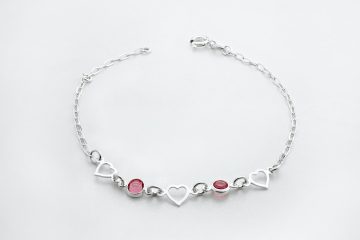In today’s modern world, we are constantly searching for ways to enhance our sleep quality, as a good night’s rest is crucial for our overall well-being. With the rise of wearable technology, sleep bracelets have gained popularity as a potential solution to improve sleep. These bracelets claim to use innovative technology to track and regulate sleep patterns, leading to a more restful night. However, the question arises: is it safe to sleep with a bracelet on, or does it pose risks to our sleep quality and overall health? In this article, we will explore the topic in depth, examining the benefits, potential risks, and considerations one should keep in mind before deciding to sleep with a bracelet on.
1. The Promise of Sleep Bracelets
Sleep bracelets are designed to deliver various features that aim to improve sleep quality. Some of these features include sleep tracking, relaxation techniques, and even subtle vibrations to promote better sleep. These bracelets often utilize sensors that monitor heart rate, movement, and body temperature to provide insights into sleep patterns. By analyzing these data points, sleep bracelets claim to help users understand their sleep cycles, identify disturbances, and make necessary adjustments to improve their sleep.
2. The Potential Benefits
Sleep bracelets offer several potential benefits that attract users seeking better sleep. Firstly, the ability to track sleep patterns can provide valuable information about the quality and duration of sleep. This awareness empowers individuals to make lifestyle changes that can positively impact their sleep. Additionally, sleep bracelets may provide relaxation techniques, such as guided breathing exercises or calming vibrations, which can help users unwind and prepare for a restful night.
3. Enhanced Sleep Awareness
One of the key advantages of sleep bracelets is the ability to gain deeper insights into one’s sleep patterns. By analyzing data such as sleep duration, sleep stages, and disturbances, users can understand their sleep quality on a more granular level. This awareness can help identify factors that disrupt sleep, such as caffeine consumption, late-night screen time, or an uncomfortable sleeping environment. Armed with this knowledge, individuals can make informed decisions to optimize their sleep routine and create a more conducive environment for rest.
4. Lifestyle Adjustments
The data provided by sleep bracelets can prompt users to make necessary lifestyle adjustments to improve sleep quality. For instance, if the bracelet indicates a lack of deep sleep, individuals may consider adjusting their bedtime routine by incorporating relaxation techniques or creating a calming sleep environment. Similarly, if the bracelet detects excessive movement during sleep, users may explore options to reduce stress levels or seek medical advice if necessary. Sleep bracelets, therefore, act as a catalyst for positive changes that can ultimately lead to a better night’s rest.
5. Potential Risks and Concerns
While sleep bracelets offer potential benefits, it is essential to consider the potential risks and concerns associated with wearing them during sleep. Firstly, some individuals may find wearing a bracelet uncomfortable or restrictive, which can hinder their ability to fall asleep or maintain a comfortable sleeping position. Additionally, sleep bracelets that emit vibrations or other stimuli may inadvertently disrupt sleep rather than enhancing it, especially for individuals who are sensitive to external disturbances. It is crucial to experiment with different bracelet types and features to find the most suitable option for one’s individual needs.
6. Skin Irritation and Allergies
Another concern related to wearing a bracelet during sleep is the possibility of skin irritation or allergic reactions. Since sleep bracelets are typically worn for an extended period, the constant contact with the skin may lead to discomfort or rashes for some individuals. To mitigate this risk, it is advisable to choose bracelets made from hypoallergenic materials and ensure proper hygiene by regularly cleaning the bracelet and the area of the skin it comes into contact with.
7. Electromagnetic Radiation
Sleep bracelets that incorporate electronic components may emit electromagnetic radiation, albeit at low levels. While the long-term effects of this radiation are still under debate, some individuals may prefer to err on the side of caution and avoid wearing electronic sleep bracelets during sleep. If electromagnetic radiation concerns you, it is recommended to opt for non-electronic alternatives, such as sleep trackers that can be placed under the mattress or on the bedside table.
8. Personal Comfort and Preference
Ultimately, the decision to sleep with a bracelet on depends on personal comfort and preference. While some individuals may find sleep bracelets beneficial and experience an improvement in sleep quality, others may not find them suitable or comfortable. It is essential to listen to your body and pay attention to how you feel when wearing a bracelet during sleep. If you find it hampers your ability to relax or it causes discomfort, it may be best to explore alternative sleep-enhancing methods.
9. Optimal Use and Best Practices
For those who choose to sleep with a bracelet on, there are certain best practices to ensure optimal use and minimize potential risks. Firstly, it is advisable to select a bracelet that fits comfortably and securely, without being too tight or loose. This ensures both comfort and accurate data collection. Additionally, charging the bracelet regularly and keeping it updated with the latest software ensures the device functions optimally. Lastly, following the manufacturer’s instructions for maintenance and cleaning will help prevent skin irritation and maintain the longevity of the bracelet.
10. Conclusion
In conclusion, sleeping with a bracelet on can offer benefits such as enhanced sleep awareness, lifestyle adjustments, and relaxation techniques. However, it is crucial to consider potential risks such as discomfort, skin irritation, and electromagnetic radiation. Ultimately, personal comfort and preference should guide the decision to sleep with a bracelet on. By understanding the potential benefits and risks, individuals can make an informed choice that aligns with their sleep goals and overall well-being.
FAQs
1. Can sleep bracelets cure insomnia?
Sleep bracelets are not a cure for insomnia. They can, however, provide insights into sleep patterns and offer relaxation techniques that may assist in managing insomnia symptoms. It is recommended to consult a healthcare professional for a comprehensive approach to treating insomnia.
2. Can sleep bracelets replace medical advice for sleep disorders?
Sleep bracelets should not replace medical advice for diagnosing or treating sleep disorders. While they can provide valuable information, it is always advisable to consult with a healthcare professional for proper diagnosis and treatment.
3. Are sleep bracelets suitable for all age groups?
Sleep bracelets are generally safe for use by adults. However, it is advisable to check the manufacturer’s guidelines and consult with a healthcare professional before using sleep bracelets for children or individuals with specific health conditions.
4. Do sleep bracelets work without a smartphone connection?
While some sleep bracelets require a smartphone connection to access advanced features and data analysis, many can function independently without the need for a smartphone. It is important to review the specifications of the specific sleep bracelet to determine its functionality.
5. Can sleep bracelets be worn by individuals with sensitive skin?
Sleep bracelets made from hypoallergenic materials are suitable for individuals with sensitive skin. It is recommended to choose bracelets that are specifically designed to be skin-friendly and regularly clean the bracelet to prevent skin irritation.




